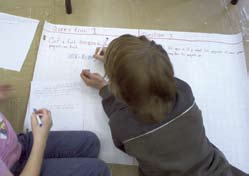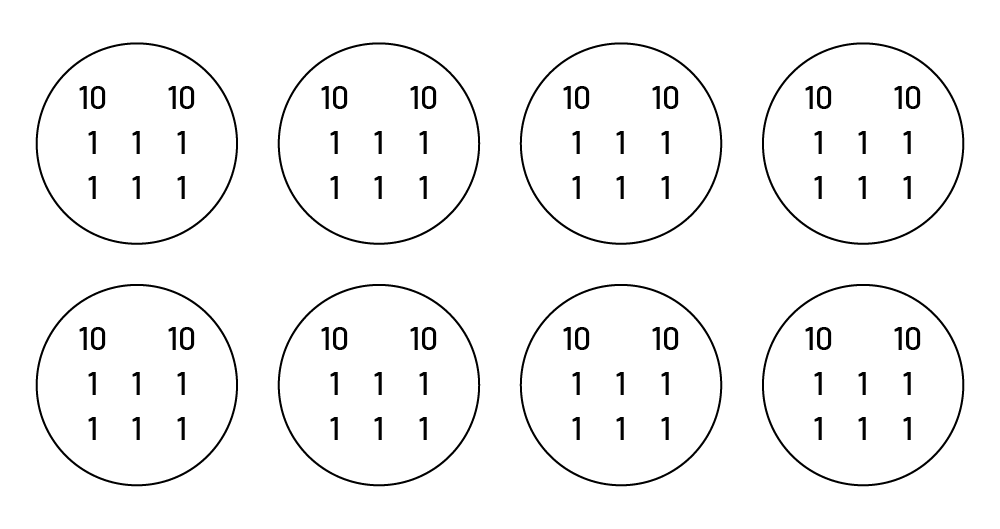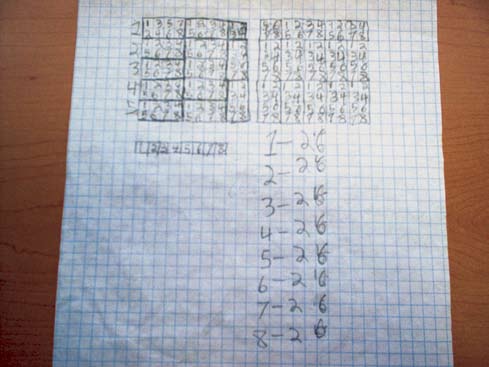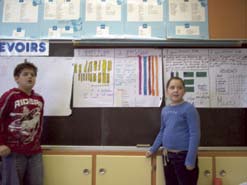B2. Operations
Demonstrate an understanding of numbers and make connections to the way numbers are used in everyday life.
Learning Situation: Healthy Gum!
Total duration: approximately 90 minutes
| Overall Expectations | Specific Expectations |
|
B2. Operations Use knowledge of numbers and operations to solve mathematical problems encountered in everyday life. |
B2.2 Recall and demonstrate multiplication facts for 1 × 1 to 10 × 10, and related division facts.
B2.6 Represent and solve problems involving the division of two- or three-digit whole numbers by one-digit whole numbers, expressing any remainder as a fraction when appropriate, using appropriate tools, including arrays. |
Learning Goals
The purpose of this learning situation is to allow students to:
- recognize which meaning of division a given situation relates to: the "equal-grouping" sense (measurement division where the number of groups is unknown) or the "equal-sharing" sense (partitive division where the size of the groups is unknown) ;
- develop personal division strategies or algorithms.
In this learning situation, students explore the concept of division by solving a problem involving the manufacturing and packaging of a product.
| Learning Situation | Prerequisites |
|---|---|
| In the primary grades, students are introduced to division in a problem-solving context involving equal grouping and equal sharing using concrete materials and develop an understanding of basic number facts related to division up to 100. In Grade 4, students use personal strategies and prior knowledge to solve problems involving division of a three-digit whole number by a one-digit whole number. | This learning situation provides two different situations that involve division. By comparing them and using various strategies to solve them, students develop their understanding of division.
To be able to complete this learning situation, students must:
|
Mathematics Vocabulary
quotient, divisor, dividend, table of values
Material
- Appendix 4.1 (Chewing Gum Factory) (1 copy per team)
- interactive whiteboard
- chart paper (1 sheet per team)
- manipulatives (for example, interlocking cubes, counters, base ten materials, relational rods)
Before Learning (Warm-Up)
Duration: approximately 15 minutes
Ask students if they have ever visited a factory that manufactures and packages any product (for example, chocolate factory, water bottling plant) or if they have ever seen a feature story about it.
Discuss with them the different packaging formats used by manufacturers (for example, chocolate bars in 4-packs, water bottles in 12- or 24-pack cases).
Present the following scenario in an interesting context. For example, tell students:
The other day, I saw a feature story on television about a manufacturer of chewing gum that is planning to go healthier. The manufacturer is conducting trials to develop chewing gums that would have a unique flavour and be enriched with vitamins and minerals. To make this new product stand out from other chewing gums currently on the market, he plans to sell it in a package containing 8 gums of different flavours.
As a class, ask students to suggest unique flavours for the chewing gums (for example, blueberry, carrot, banana yogurt, bran muffin, green tea, honey-lemon, berries, mango). From all the suggestions received, agree on a selection of 8 flavours with them.
Note: The students' selection of the eight flavours makes the learning situation more engaging and facilitates the solution of the second part of the problem.
Ask students to imagine that the manufacturer agrees to make its packages of gum using the eight flavours chosen by the class, that is, each package of the new product will include eight different flavours of gum. Present the problem in Appendix 4.1 on the interactive whiteboard or on a chart paper to students.
Make sure students understand both parts of the problem, by asking them to explain it in their own words. To make the problem more concrete, show an 8-pack of chewing gum or draw a model of it on the board.
Active Learning (Exploration)
Duration: approximately 55 minutes
Divide students into pairs and distribute a copy of Appendix 4.1. Provide them with manipulatives, sheets and graph paper.
Observe students and support them in their work, but do not tell them how to solve the problem. Use strategic prompting to get them to think about:
- the strategies to be used to solve each of the two parts of the problem;
- what is unknown in each of the two parts.
Allow sufficient time for students to explore and discuss various problem-solving strategies.
Circulate and ask questions such as:
- How else can you represent this situation?
- How can you be sure that this solution is true?
- Why does your strategy work?
Note: If students know the usual algorithm for division, suggest that they solve the problem using a different strategy and then perform the usual algorithm to check the result.
Strategies that students can use to solve each part of the problem include the following.
Part 1 How many packages of gum will the manufacturer produce?
Students can:
- perform repeated subtractions;

Example
\(\begin{array}{l}208\; - \;8\; = \;200\\200\; - \;8\; = \;192\\192\; - \;8\; = \;184\\ \ldots \\8\; - \;8\; = \;0\end{array}\)
They then count how many times they have subtracted 8.
- build a table of values;
Example
| Number of Packages | 1 | 2 | 3 | 4 | 5 | 6 | 7 | 8 | 9 | 10 | 20 | 26 |
| Number of Chewing Gums | 8 | 16 | 24 | 32 | 40 | 48 | 56 | 64 | 72 | 80 | 160 | 208 |
Note: In the example above, students used the doubles strategy by going from 10 to 20 packages of gum.
- use manipulatives, pictures, or graph paper to represent groups of 8.
Example

Part 2 How many gums of each flavour should the manufacturer make?
Students can model how the gum will be packaged using the eight flavours:
- with manipulatives, such as interlocking cubes of different colors;
Example

- symbolically
Example

Students can also use the same type of representation for both parts. In the example below, students first used graph paper to represent the base ten blocks (flats and small cubes). Students represented the number 208 by drawing representations for 2 flats and 8 small cubes. Groups of 8 were outlined and counted. There were 26 groups (part 1). Then, students numbered from 1 to 8 in each group to represent the 8 flavours (part 2). Students then counted that there were 26 times flavour 1, 26 times flavour 2, and so on.
Example

| Possible Observations | Possible Interventions |
|---|---|
| Teams have difficulty stating a correct mathematical statement to justify the calculation when students combine groups of 8 (for example, \(16\; + \;16\; + \;16\; = \;6 \;{\rm{groups}}\)). | Help them to separate the groups using interlocking cubes and encourage them to review the mathematical statement. |
| Some teams use rods to represent groups, but forget that a rod represents 10 when the problem has groupings of 8. | Invite them to compare the number of unit cubes in a rod with the number of gums in a package. |
| One team has difficulty telling the difference between the number of gums per package and the number of gums of each flavour. | Suggest that students use cubes of the same colour to represent the gums in a package (part 1) and cubes of 8 different colours to represent the eight flavours (part 2). |
| Some teams point out that the answer (26) is the same for both parts of the problem without distinguishing between 26 packages of 8 gums and 26 gums of each of the 8 flavours. | Invite them to explore the problem with the manipulatives.
Ask questions such as:
|
Once both parts of the problem are solved, have students prepare a presentation for the math exchange.
Tell them to:
- record strategies on chart paper;
- keep the manipulatives used to support their presentation;
- use clear and convincing mathematical arguments.
Circulate and select the teams that will present during the math exchange.
Target teams that used different computational strategies.
Note: The choice of teams who will present their solution is very important since it is through the different presentations that students can compare their strategies, consolidate their learning and, at the same time, verify their understanding of the concept of division.
Consolidation of Learning
Duration: approximately 20 minutes
Discuss one part of the problem at a time. Ask the selected teams to take turns presenting their approach. After each presentation, the other students contribute to the discussion and enrich the math exchange by asking questions and making pertinent observations while showing signs of respect.
Encourage students to use precise vocabulary and causal terms. Encourage them to reflect on their learning by asking questions, as needed, such as:
- Who would like to explain in their own words the strategy just presented?
- Is this an effective strategy?
- Have other students used this or a similar strategy?
- What are the similarities between the strategies used by these two teams (for example, a team that forms groups of 8 and a team that uses a table of values)?

When the selected teams have completed their presentations, point out the similarities and differences between the two parts of the problem by asking questions such as:
- What is unknown in the first part? in the second?
- How are the two parts of the problem similar? different?
Be sure to highlight:
- that division implies separating the whole into equal groups;
- that various strategies can be used to perform a division;
- that there are two division types, the "equal-sharing" division and the "equal-grouping" division. (Students do not need to know these terms; they just need to understand that the quotient can represent two types of quantity)
It is also important to note that it is possible to represent each of the two parts of the problem using the equation \(208\; \div \;8\; = \;26\). What is different is the meaning given to the numbers in each equation:
- In Part 1, write: 208 gums ÷ 8 gums per package = 26 packages.
- In Part 2, write: 208 gums ÷ 8 flavours = 26 gums of each flavour.
Note: Mention terms specific to division such as quotient, divisor and dividend.
Differentiated Instruction
The activity can be modified to meet the needs of the students.
| To Facilitate the Task | To Enrich the Task |
| Decrease the number of gums produced (for example, 104 instead of 208). | Ask students to represent, for each of the two parts of the problem using an array on paper or using interlocking cubes, how the 208 chewing gums can be placed when they come out of the first machine. |
Follow-up at Home
Ask students to solve the following or a similar problem at home in two different ways without using a calculator and to explain their procedures to a family member.
For a party, I need to make bags of marshmallows. In each bag, I plan to put 6 marshmallows. If I have 108 marshmallows in total, how many bags can I make?
Note: This activity allows parents to see that it is possible to perform division without using the usual algorithm.
Extension - Building Structures
Present a two-part problem, similar to the one in the learning situation, so students can use the various strategies presented in the math exchange.
Example
Teachers ask their students to build a structure using interlocking cubes.
The teacher asks Eric to distribute 196 interlocking cubes to 7 teams. How many interlocking cubes should Eric give to each team if each team is to receive the same number of cubes?
The teacher then asks the teams to exchange their structures and use another set of interlocking cubes to build a structure identical to the one received. To do this, the teacher asks Louise to distribute another 196 cubes to the teams. She gives Louise a box full of small bags containing 7 cubes each. How many bags does Louise need to take if she wants to ensure that she distributes 196 cubes in total?
When the teams have finished, conduct a math exchange to highlight the different strategies used. As in the previous learning situation, ask students to explain what the numbers represent in each of the two parts of the problem.
Source: translated from Guide d'enseignement efficace des mathématiques de la 4e à la 6e année, Numération et sens du nombre, Fascicule 1, Nombres naturels, p. 167-176.
